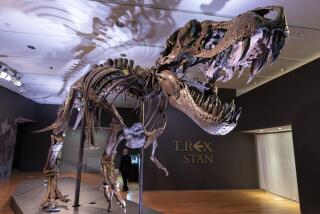Scientists Find Rare Tyrannosaurus Skeleton in Canada : Paleontology: Experts confident Saskatchewan site contains complete remains of T. Rex because of bones recovered so far.
TORONTO â Scientists announced Wednesday that they have discovered what they believe is an intact skeleton of a Tyrannosaurus rex in a hillside in southwestern Saskatchewan.
The rare finding--fewer than a dozen complete specimens of the giant, flesh-eating dinosaur have been excavated--was disclosed by John Storer, curator of earth sciences at the Royal Saskatchewan Museum in Regina.
Storer said the part of the skeleton uncovered so far--including six-inch teeth--âleads us to believe that itâs not only a Tyrannosaurus rex , but a bigger than usual specimen of Tyrannosaurus rex .â
The dinosaur stood more than 18 feet tall, was about 50 feet long and weighed about six tons, Storer said in a telephone interview.
Few dinosaurs have captured the public imagination like T . rex , which is Greek for âterrible lizard.â
The beast walked upright on two powerful hind legs supported by a long tail and roamed western North America about 65 million years ago in the late Cretaceous period. Depictions of the creature as a monstrous villain populate countless movies, most recently âJurassic Park,â where one dines on a venal lawyer.
The Saskatchewan fossil was discovered in 1991, but it was not until this year that researchers knew the extent of their find.
Paleontologists have so far excavated part of the upper jaw, several vertebrae, a leg and some teeth.
Storer said the dig team is increasingly confident that they have found a complete skeleton because they have found bones from various parts of the animal and because they are finding portions usually subject to early destruction by erosion.
The bones are piled together haphazardly, suggesting that the T. rex may have been torn apart by an ancient scavenger, Storer said.
Excavation is expected to continue until August, when the skeleton will be moved to the Royal Saskatchewan Museum for study and reconstruction.
âWe have a lot of work to do,â Storer said.
The site is on private property near the town of Eastend, 217 miles southwest of Regina. Storer said the area is the site of many dinosaur fossils, particularly triceratops and thescelosaurus , a small, rare plant-eater.
But the T. rex find, he said, is âspecial. Itâs our signature dinosaur. It really draws a focus on the rich, rich story that can be told from this part of the province.â
Excavation of a complete skeleton is a rare opportunity for paleontologists.
Most museum Tyrannosauruses are composites.
âWhatâs significant is any kind of a complete skeleton, or near complete skeleton,â said Nicholas Hotton III, research paleontologist emeritus at the Smithsonian Institution. âA complete skeleton offers the opportunity to get the complete story.â
Although the first Tyrannosaurus specimen was discovered early in the 20th Century, there are unanswered questions about it. Scientists disagree, for example, whether it was mainly an active hunter or primarily a scavenger.
âOne thing we donât have is all the answers,â Hotton said in an interview. âWe keep building up and building up information and eventually, if weâre lucky, we reach a consensus.â
Aware of public interest in the dinosaur, Saskatchewan officials Wednesday suggested that the latest scientific finding could be used as a tourist draw.
Dwain Lingenfelter, the provinceâs economic development minister, said there is âgreat commercial valueâ in the finding. He and other political figures outnumbered the scientists at the news conference Wednesday, but they advanced few specifics for tourism in the region.
Lingenfelter said the excavation site will be visible to limited groups of tourists and protected by security officers.
Canadian law prohibits private excavation of fossils, Storer said, so the site is unlikely to be overrun by amateur diggers.
More to Read
Sign up for Essential California
The most important California stories and recommendations in your inbox every morning.
You may occasionally receive promotional content from the Los Angeles Times.









